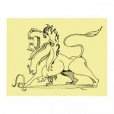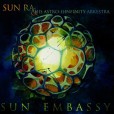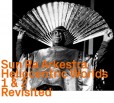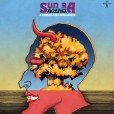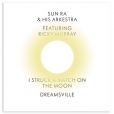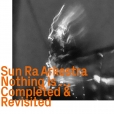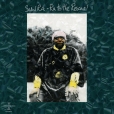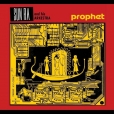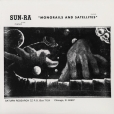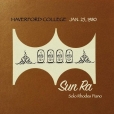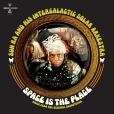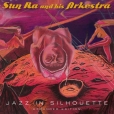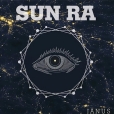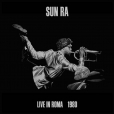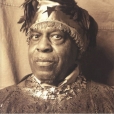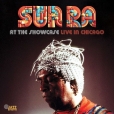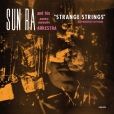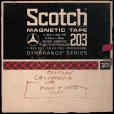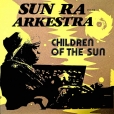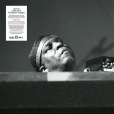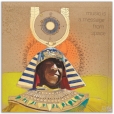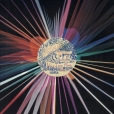Your basket is empty

From 1964, with Pharoah Sanders sitting in for John Gilmore (away working with Paul Bley, Andrew Hill and Art Blakey); also flautist Harold Murray and the brilliant bassist Alan Silva. The debut of The Shadow World.
Late-sixties recordings from Sun Studios — chez Ra — in Philadelphia.
The first-ever release of six works; plus revivals of 1950s classics Sunology and Ancient Aiethiopia; and an early treatment of Why Go To The Moon.
Fastidiously designed facsimiles of two pamphlets which accompanied early Sun Ra albums; and two substantial publications more than a decade later by Infinity Inc./Saturn Research.
Issued in 1957 by the Boston-based Transition label, his debut LP Jazz By Sun Ra contained a beautiful booklet, now as prized as the LP itself, with rare photographs and a selection of poems and proclamations, as well as the personnel and recording credits.
Ra’s Jazz In Silhouette was released two years later on Saturn Records, coming with a mimeographed, folded, unstapled booklet. The CvsD version folds this slim pamphlet of poetry into a slipcover with a classic photo portrait of Ra by Thomas “Bugs” Hunter on the back.
Perhaps Ra’s best known book of poetry, The Immeasurable Equation is restored after the original Infinity Inc./Saturn Research version, published in Chicago in 1972, and distributed widely by the Arkestra, often from the bandstand. It features more than sixty of Ra’s poems.
Finally, perhaps the rarest of Ra’s poetry books is Extensions Out: Immeasurable Equation Vol. II, which was also published by Infinity Inc./Saturn Research. This 8.5 x 11-inch book is a massive compendium of more than 130 poems, very much in step with the mimeo poetry publications of its era — simple staple binding, one-sided pages — featuring three photographs of artwork by Ayé Aton, a close ally of Ra’s in this, the period of the Arkestra classic Space Is The Place, on which Aton plays percussion. Great care was taken to reproduce the special textured cover of this highly sought after book.
In 1961 Sun Ra took off from Chicago – where he had established the Arkestra, his dedicated ensemble and the vehicle for his mission to better the planet – and with a scaled-down version of the band he landed in NewYork. Their first recording session was in Newark in October of that year. The Futuristic Sounds Of Sun Ra, recorded for the Savoy label, is a beautiful document of the material they’d honed during a long residency at the Wonder Inn at the end of the Chicago period. Among tracks left in the vault from that day in the studio were these two great ballads sung by Ricky Murray, both of them redolent of the bright popcraft that had long been part of Ra’s repertoire, with classic Afrofuturist themes of navigating outer space and altered destiny cloaked in sweet songs with tart arrangements.
“Marshall Allen especially liked playing I Struck A Match On The Moon,” recalls Ricky, “because he got a chance to light up a cigarette while we were singing.”
The definitive edition, with much better sound than any of the rather garbled ESP iterations.
‘Recorded on May 18, 1966 at St Lawrence University, Potsdam, NY, Nothing Is…Completed & Revisited has Ra, who was at the time only just beginning to perform on the US college circuit, testing the water with a programme drawn from several stages of his work with the Arkestra. There are space chants (Outer Spaceways Incorporated, Next Stop Mars, Second Stop Is Jupiter, We Travel The Spaceways), a salute to the swing era (Velvet, from the 1959 Saturn masterpiece Jazz In Silhouette), far-out material such as the sixteen minute version of Outer Nothingness from the 1965 ESP album The Heliocentric Worlds Of Sun Ra Vol. l, and trippy exotica such as reed player Marshall Allen’s oboe feature Exotic Forest, here given its first airing on disc.
‘The twelve-piece band is killer, with Allen, tenor saxophonist John Gilmore, baritone saxophonist Pat Patrick and trombonists Ali Hassan and Teddy Nance propelled by the A-team anchors Ronnie Boykins on bass and tuba and Clifford Jarvis on drums. Everyone, including Ra on clavioline and piano, is on top form’ (Chris May, All About Jazz).
‘Recorded at several locations over several years — including the legendary Squat Theater in NYC) — including everything from Ra’s sci- fi synthesizer insanity, Marshall Allen’s skronking sax, the knockout Arkestra vocal They Plan To Leave, and so much more. Reissued for the first time since its original release forty years ago.’
A triumphant edition of one of the most implacable, mysterious, rumbustiously creative albums in the entire Saturn catalogue.
The three tracks comprising the original LP are remastered from tape, doing away with the distortion which has dogged all previous issues. The four additional recordings here are previously unreleased, including two more from the first sessions, and a live performance circa 1967, with Ra leading strange strings on clavinet, and finally a demonstration by Ra of the ‘plaintive’ expressiveness of the Ukrainian bandura.
With excellent notes, including a new essay by David Toop.
‘When I say space music, I’m dealing with the void, because that is of space, too; but I’m dealing with the outer void rather than the inner void, because somehow man is trapped into playing roles into the haven or heaven of the inner void… the word space is a synonym for a multi-dimension of different things other than what people might at present think it means. So I leave the word space open, like space is supposed to be.’
‘If you play it right time, you’re wrong,’ Sun Ra once instructed his Arkestra. ‘I told you, it’s designed for sound.’
From the original Saturn Research publicity flyer for Strange Strings: ‘Too many people are following the past. In this new space age this is dangerous… It is no accident that those who die are said to have passed since those who have PASSED are PAST.’
‘In 1971 Ra accepted a lectureship at University of California, Berkeley, teaching a class titled The Black Man and the Cosmos. This course of study was held in some secrecy, apparently open exclusively to Black students who were strictly forbidden to record the lectures. Ra’s assistants did, however, document the sessions, and some of these recordings have made their way to YouTube. The incredible half-hour of Berkeley Lecture presented here, however, is previously unknown, extracted from the Creative Audio Archive’s extensive holdings. It presents Ra walking his students through a series of wonderful paradoxes and riddles, the sound of his chalk on the chalkboard serving as a kind of Greek chorus, commenting on or complementing his highly creative pedagogy. At the end of the lecture, Ra performs two musical demonstrations, the first a piano version of the Arkestra classic Love in Outer Space, followed by a blistering 16-minute solo on the Moog synthesizer.’
Beautifully presented in die-cut, screen-printed jackets, with printed inner sleeves.
‘The infinitely wise drum-driven solar chant of Children Of The Sun, with the profoundly meditative & deeply relevant-to-now space chant They Plan To Leave.’
Both from Ra To The Rescue.
Tiny run.
Beautifully presented in die-cut, screen-printed jackets, with printed inner sleeves.
‘Two versions of one of Ra’s most enduring compositions. The classic take featuring vocals by David Henderson, and an alternate instrumental version never before released on vinyl, featuring the almighty John Gilmore on the drum kit!’
Tiny run.
Sensational price for easily the most outstanding release on RSD 2025, imperiously superseding Shandar’s selection of edits.
The Arkestra at its magnificent peak, in its very first performances outside North America (complete with dancers, light-shows, and psychedelic projections of New York and Chicago, moon rockets, Egyptian Gods and plumed African warriors).
‘Plenty of fiery avant-garde action,’ notes Daniel Spicer in The Quietus. ‘Much of this emanates from Ra’s solo interludes. On piano, he remains a suis generis genius of spontaneous creation, drifting from wistful melodic daydreams to sudden irruptions of violent intensity and back again.
‘Around this time, at the turn of the 1970s, he had also begun his tumultuous explorations of the recently purchased Moog synthesizer. Here, Ra approaches the synth not as an electric guitar substitute, as contemporaries such as The Mahavishnu Orchestra’s Jan Hammer were then doing, but as a furious generator of alien sounds and timbres as though beamed in from some far galactic outpost. There are also group improvisations of boiling energy – often conducted by Ra using a lexicon of theatrical gestures – which forge ahead into the most coruscating free jazz, with saxophonists John Gilmore and Marshall Allen straining at the horn’s limits.
‘And yet, for all that, the shows were approachable, enjoyable and, above all, fun. Across the four hours of music, a wide range of moods are touched upon. There are the many anthemic songs and chants – such as Satellites Are Spinning and We Travel The Spaceways – delivered in vocalist June Tyson’s sweet, down-home tones with enthusiastically ragged call-and-response choruses by the rest of the Arkestra spelling out Ra’s sci-fi philosophy. There are wafting space-ballads; muscular, big band hard-bop workouts; and percussion-heavy rainforest modal jams. Each of the two evening programmes feels like a meandering yet comprehensive journey into the deepest recesses of Ra’s imagination, calling in on all his obsessions and preoccupations.’
‘New and archival recordings all orbiting around the intergalactic soundscape introduced by Sun Ra. Ra’s own a capella I Don’t Believe in Love, recorded by Ra at home in Chicago during the 1950s, kicks the program off. This intimate private recording is followed by two intense new solo improvisations by French guitarist Raymond Boni, one acoustic and one electric, inspired by seeing the Arkestra preparing for a gig in Arles in 1976. The first side wraps up with Jason Adasiewicz’s riveting unaccompanied vibraphone workout on Ra’s Lanquidity and Where Pathways Meet. With a completely different take on Lanquidity, Side Two begins with four wild remixes by legendary Cologne techno pioneer Wolfgang Voigt, using layered samples from the LP. Hailing from the intersection of free jazz and out rock, Ken Vandermark’s band Spaceways Inc., with bassist Nate McBride and drummer Hamid Drake, continue with a Ra medley, in collaboration with the Italian band Zu. And where the program started in disbelief, love-skepticism, it concludes with Joe McPhee’s emphatic loving embrace on Cosmic Love, a classic tenor/synth sound-on-sound recording from 1970.’
With cover art by Emil Schult, who designed classic 1970s LPs for Kraftwerk. Very limited.
